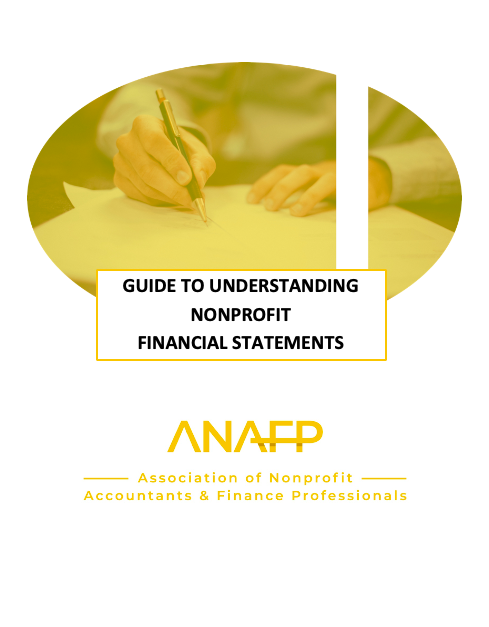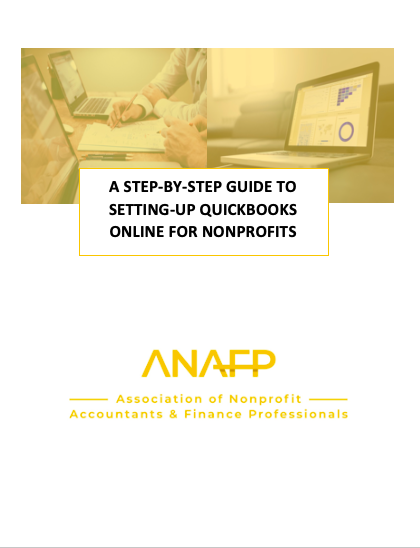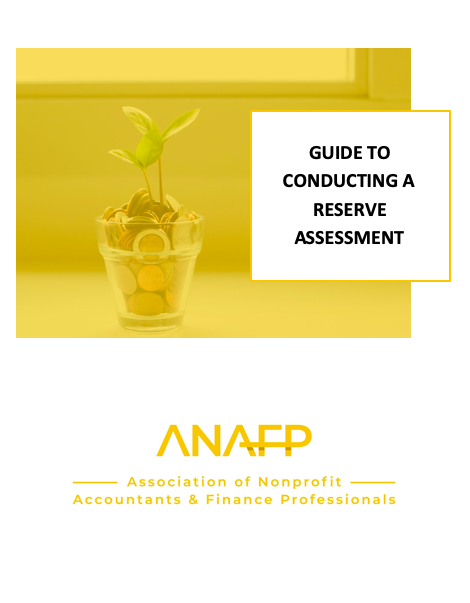- Home
- Professional Resources
- Financial Management
Financial Management Resources
Every nonprofit deserves well-educated accounting and finance staff.
Sign-up for ANAFP Publications and Emails.
|
32 Financial Ratios for Every Nonprofit
Financial ratios help nonprofits measure the financial health of the organization. A nonprofit that tracks important financial ratios are not only in a better position to evaluate an organization’s operations, programs, and financial stability, the results may also be used to benchmark the organization against management objectives, past performance, and similar organizations and competitors. |
| Guide to Conducting a Reserve Assessment (member only) Many nonprofit organizations have or are interested in establishing a reserve fund to sustain the long-term future of the organization and/or provide the organization a source of capital for future development. Learn the six essential steps that every nonprofit should take to determine the ideal reserve fund amount. |
| Managing Foreign Exchange Risk for Nonprofits (member only) More and more nonprofits are operating and/or expanding internationally. Although this expansion is a welcome sign that the organization is growing and expanding services, it also creates a new set of problems -- how to mitigate foreign exchange exposure and prevent unnecessarily losses due to fluctuating foreign currency rates. |
Overview of Fund Accounting for Non-Profits
The concept of fund accounting is one of the main differences between for-profit and non-profit accounting. Its name comes from the fact that revenues and expenses are segregated in the accounting system into “funds” for the purpose of tracking each fund separately – primarily for reporting purposes. Learn more about fund accounting and how to apply these concepts. |
Guide to Understanding Nonprofit Financial Statements Everyone working in nonprofit accounting and finance, including Board members, should have a strong grasp of reading and understanding nonprofit financial statements. ANAFP's Guide to Understanding Nonprofit Financial Statements will walk you through each financial statement so that you will understand how to interpret the information presented. |
| Cost Allocations and the Statement of Functional Expenses (member only) The Statement of Functional Expenses is a key financial report for nonprofit organizations. To complete this statement accurately, nonprofits must understand which costs can be allocated and how to distribute them properly across functions. |
| How to Protect Your Nonprofit from Financial Fraud Fraudulent transactions are on the rise. From unauthorized deductions from bank accounts to a lack of internal controls, nonprofits are at risk of falling prey to malicious acts. Follow these 8 steps to ensure your organization isn't a victim of fraud. |
| Setting Executive Compensation and Benefits It is the responsibility of the Board of Directors to set the compensation and benefits package of the CEO/Executive Director. What guidance does the IRS provide nonprofits when setting this compensation and benefits package? What documentation is essential to obtain and review to ensure the compensation is reasonable and not excessive? |
Key Differences Between Capital & Operating Leases
Many nonprofits opt to lease assets instead of purchasing them outright. Learn how to differentiate between capital and operating leases, how to determine which lease your asset falls under, and how to record the leases in the accounting system. |
How to Calculate Indirect Rates (member only) Many nonprofits develop indirect rates as a mechanism for allocating joint costs among multiple projects and donors. Learn more about what constitutes indirect costs and how to calculate indirect rates. And discover strategies on how to ensure you recover your indirect costs when faced with indirect caps on grants and contracts. |
| Annual Timeline for Managing a Nonprofit's Budgets (member only) Given the complexity in nonprofit budgeting, nonprofits must continuously stay on top of their operating and program budgets. Learn ANAFP’s suggested timeline for an ideal budget development and ongoing budget review process. The timeline sets forth the tasks that should be completed each month to keep the organization’s budgeting process on track. |
| Managing Cash Flow at a Nonprofit (member only) Cash flow management is critical for the success and sustainability of any nonprofit. Explore strategies to effectively manage a nonprofit's cash flow -- ensuring the organization can meet its obligations, invest in its mission, and achieve long-term financial sustainability. |
| Nonprofit Budgeting Concepts and Processes (member only) Nonprofits operate with a limited amount of cash. And, similar to for-profits which have various product and service lines, nonprofits should budget and track revenues and expenses for multiple program service areas. However, before a nonprofit begins the budgeting process, there are key concepts and terms that all members of the organization should understand. |
How to Account for Uncertain Tax Positions (member only) Nonprofits are required to account for uncertain, material tax positions in the accounting system and include such information in their financial statements. Determining if a nonprofit has any such positions requires a careful inventory of all tax positions and then deciding if any of these are uncertain. This article will provide an overview for conducting this analysis and explore common areas of uncertain tax positions. |
| Budget Forecasting for Nonprofits (member only) Often times it becomes evident that actual revenues and expenses may not coincide with an organization's originally projected targets. When this occurs, it is often necessary to realign the budget through forecasting. Budget forecasting allows nonprofits the flexibility to adjust expectations in an ever-evolving business landscape. |
| What Constitutes Fundraising Costs Nonprofits are required to track and report expenses by three functional areas: program services, general and administrative, and fundraising. But what constitutes fundraising costs and how do these costs differ from development costs? Learn more about the definition of fundraising to help ensure your organization is accurately reporting, and not over-reporting, these expenses. |
| Preparing for Virtual Audits - Technology Improvements for Every Nonprofit Technology is consistently changing the way business is conducted, and this even applies to how some financial audits are currently and will be conducted in years to come. Learn seven steps for making your organization more technology-driven so you'll not only be prepared for virtual audits, but you'll also improve your organization's systems and processes. |
| Internal Control: What is the COSO Internal Control Framework The Committee of Sponsoring Organizations of the Treadway Commission (“COSO”) established a model for evaluating internal controls for organizations. This model was adopted as the generally accepted framework for internal control, and it is widely recognized as the definitive standard against which organizations measure the effectiveness of their internal control systems. |
| How to Calculate the IRS Public Support Test Nonprofits in the United States who function as public charities must pass the IRS public support test in order to remain classified as a public charity. Failing the test will have serious consequences as it will cause the public charity to be reclassified as a public foundation. Learn how to calculate your nonprofit's public support in order to properly file your annual tax return. |
| IRS Public Disclosure Rules for Nonprofits (member only) A tax-exempt nonprofit in the United States must comply with the Internal Revenue Service disclosure requirements. Learn about these requirements, how to meet the requirements, how to recover costs associated with meeting these rules, and which information nonprofits are not required to disclose. |
Guide to Setting-up QuickBooks Online for Nonprofits (member only) Be sure to properly set-up your nonprofit's QuickBooks Online account by downloading and reading ANAFP's Guide to Setting-up QuickBooks Online for Nonprofits. This guide will walk you through, step-by-step, the setting changes and edits you will need to make to QuickBooks Online so that you can accurately track revenues and expenses by donors, grants, projects, and service areas. |
|
Migrating from Paper Checks to E-Payments
Technological advances have revolutionized the way organizations operate, and the continued prevalence of paper checks in payment processes stands out as a bottleneck for many nonprofits. Discover the challenges surrounding the use of paper checks and how best to migrate to e-payments. |
| Key Differences Between a Public Charity and Public Foundation Nonprofits in the United States organized under U.S. IRS Code Section 501(c)3 may be classified as either a public charity or a private foundation. Learn the key differences between these two entities to ensure your organization is classified correctly. |
| Understanding a Nonprofits Statement of Cash Flows (member only) Learn about the key components of a nonprofit's statement of cash flows and how to properly interpret this important statement. Understanding the statement of cash flows is essential for assessing the financial health and sustainability of any nonprofit organization. |
Downloadable ANAFP Guides



